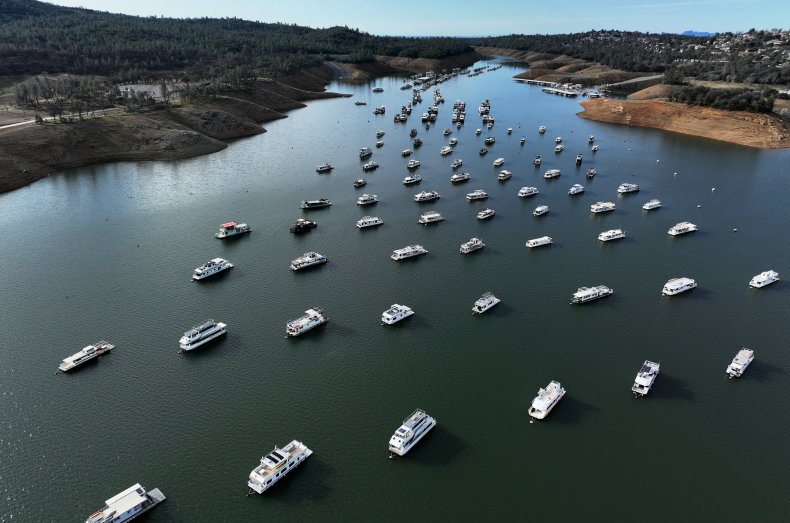California Reservoir Photos Show Massive Recovery After Record Rain
- California received above-average precipitation from January through March, according to a National Oceanic and Atmospheric Administration report.
- Photos show that the state's reservoirs have benefited from the heavy rainfall and are now higher than they've been in years.
- Twelve of the state's 17 major reservoirs are now filled above their historical average levels for the start of the spring season.
- However, the excessive precipitation has brought its own set of challenges, such as Tulare Lake refilling and some reservoirs becoming too full.
Parts of eastern California are emerging from their wettest start to the year on record, according to a report from the National Oceanic and Atmospheric Administration (NOAA).
The surprising turnaround means the Golden State is chasing away its long, severe drought, with reservoirs overflowing for the first time in years. An excessively wet winter brought more than a dozen atmospheric rivers—and substantial rain—to California. In addition, the NOAA report, which includes precipitation information for the United States from January through March, shows that much of California has received above-average precipitation.
The storms have supplemented many of the state's largest reservoirs, bringing an end to a years-long drought that has been documented by the U.S. Drought Monitor map. Many reservoirs are fuller than they've been for years.
While some major reservoirs, like Lake Mead and Lake Powell, are still struggling with recovering water levels, photos published by the Associated Press on Sunday show a startling recovery of several state reservoirs from the high precipitation.
"A series of powerful storms dumped rain and snow across California, refilling depleted reservoirs and mostly bringing an end to the state's drought. Lake Folsom and Lake Oroville show the dramatic changes," the Associated Press tweeted on Sunday.
A series of powerful storms dumped rain and snow across California, refilling depleted reservoirs and mostly bringing an end to the state's drought. Lake Folsom and Lake Oroville show the dramatic changes.
— The Associated Press (@AP) April 9, 2023
See the transformation: https://t.co/2PDh27Lam9 pic.twitter.com/QSAO478oTX
The photos showed Northern California's Lake Oroville and Folsom Lake in north-central California benefiting from a startling recovery that has beneficially affected the area's landscape. Houseboats floating on Lake Oroville showed a far different picture compared with August 2021, when nearly half the state was plagued by excessive drought and almost 90 percent was suffering from exceptional drought.

Similar photos show a road passing over Lake Oroville, with the water levels now shockingly higher than those seen in May 2021.
Folsom Lake shows a similar recovery, as May 2021 photos reveal boat docks stranded on dry land after the water levels receded. Nearly two years later, the docks are now floating in the recovered lake.
The Drought Monitor's map now shows more than half of California is free from drought.
California has surpassed a dozen atmospheric rivers—a corridor of concentrated, tropical moisture traveling through the atmosphere—since its wet season began in the fall. The precipitation has benefited other reservoirs throughout the state. The AP reports that 12 of the state's 17 major reservoirs were filled above their historical average levels for the start of the spring season.
The NOAA also said that much of north-central, central and southwestern California received rainfall that was "much above average." A swath of east-central and a patch of west-central California received its wettest start to the year on record. The precipitation hitting the Western U.S. extended into Nevada, Utah and Arizona as well.
The excessive precipitation has brought a host of new challenges as well, with portions of California receiving too much water. Tulare Lake—a long-lost lake that is now a haven for farmers—is refilling, and some reservoirs are releasing water after becoming too full.
Newsweek reached out by email to the NOAA and AccuWeather for comment.








